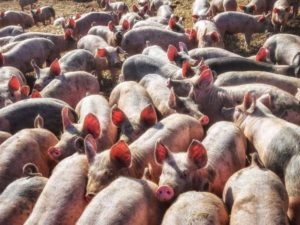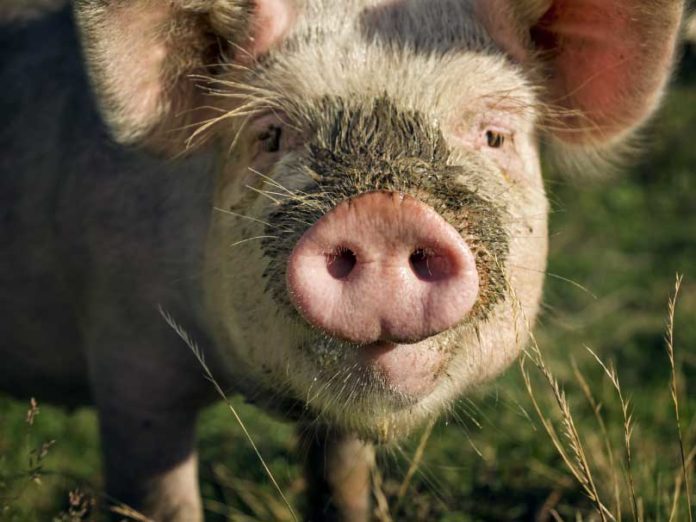Pork is the most widely-consumed meat in the world, accounting for around 40 percent of the world’s total meat consumption. But while many are munching away on pork chops, bacon, sausage, and smoked ham, they are grossly unaware of the potential health dangers this seemingly harmless meat poses.
Pork is not only filled with toxins, it’s often riddled with antibiotics and parasites, and is high in a specific type of inflammation-causing fatty acid. While animal proteins like beef, bison, lamb, and fish can be a component of a healthy diet, it’s best to avoid pork completely.
From Farm to Table
Much like shrimp are referred to as the bottom feeders of the ocean, pigs are often considered the vacuum cleaners of the farm. They will eat anything they come across, from scraps, bugs, and insects to their own feces and the flesh of other dead animals, including cancerous tumors! In an effort to keep food costs down, some farmers will take advantage of this trait and feed their pigs garbage, like rotting meat and vegetables. This isn’t a problem for the pig since their bodies were designed for the task of clean up; but it does translate to an issue for the end consumer: you.
In most animals, the process of digestion is a lengthy one, taking anywhere from 12 to 24 hours. This gives the animal’s body enough time to filter out many toxins, poisons, parasites, and any other undesirable substances for removal. However, pigs have unique digestive systems. For a pig, the entire digestive process takes only four hours. Because this process is so short, it doesn’t give the pig’s body enough time to filter out all the toxins. Instead, many of these toxins become stored in the fatty tissues – the part of the animal that’s typically consumed by humans. This would be an issue even with a normal diet, but it becomes a significant problem with the amount of toxins that pigs consume in the first place.
Another toxin-related issue is connected to the way pigs sweat; or more accurately, the fact that they don’t. Pigs have very few functional sweat glands, which makes the phrase “I’m sweating like a pig” wildly inaccurate. Pigs don’t sweat much at all, and since sweat is another route of detoxification, the inability to remove toxins through this avenue contributes to making the pig a toxic wasteland.
Inhumane Treatment
It’s no secret that animals raised on factory farms are treated poorly, and pigs are no exception. It’s estimated that 97 percent of pigs in the United States are raised in factory farms. This means that these animals likely never even see sunlight or breathe in fresh air. Instead, they’re typically crammed into a farm building with barely any room to move. In some cases, the pigs can’t even turn around and are forced to spend their lives standing in their own feces, urine, and vomit. Pregnant pigs are put in gestation crates, which are even more tightly packed. This confinement increases the pig’s risk of urinary tract infections, weak bones, and lameness.
This causes an immense amount of distress to the animals and they can become so depressed and emotionally traumatized that they have been known to bite one another’s tails and ears off. What makes this inhumane treatment even more unsettling is that pigs are considered highly intelligent creatures with the capacity to both feel and express emotions.
Parasites In Pork
Pigs carry a variety of parasites in their bodies, and unlike most bacteria, it’s hard to kill many of these parasites with cooking. Although several different types of parasites, including Toxoplasma gondii, Sarcocystis, and Taenia can infect pork, Trichinella is the most common.
The Trichinella worm most often lives in cysts of the pig’s stomach. When these cysts burst open, the larvae of the worm are released into the pig’s body, where they take up residency in the pig’s flesh – the part that ends up on a dinner plate.
When a human eats pork that is infected with Trichinella, the larvae, which are enclosed in a cyst, make their way down the digestive tract and into the stomach. When these cysts are exposed to stomach acid and pepsin, an enzyme that helps break down proteins, they burst open and the Trichinella larvae are released. These larvae then travel to the small intestine and eventually develop into adult worms, ranging from 1.2 mm to 2.2 mm in length, depending on whether the worm is male or female. The adult worms stay in the bowel for up to four weeks, where they produce more larvae. At this stage in the infection, a person may experience nausea, fatigue, diarrhea, and abdominal pain.
As the infection progresses, the new larvae can travel from the small intestine to the bloodstream and muscle tissue, causing a more serious infection and symptoms like headache, weakness, muscle pain, fever, sensitivity to light, pink eye, and swelling of the face. Once the larvae reach the muscle, they can become encapsulated in a cyst and stay there for years.
If the infection becomes severe, the Trichinella larve can travel to the vital organs, resulting in serious complications, including:
- Myocarditis – inflammation of the myocardium, the thick, muscular layer of the heart wall
- Encephalitis – inflammation of the brain
- Meningitis – inflammation of the membranes surrounding the brain and spinal cord
- Pneumonia – inflammation of the lungs
Although Trichinosis is the most common infection associated with the consumption of pork, it’s possible to develop other types of infections as well. Some of these possible infections include:
- Taenia solium – an intestinal parasite that causes loss of appetite
- Hepatitis E – a viral infection that leads to inflammation and can cause fatigue, nausea, and jaundice. Severe cases of Hepatitis E can lead to cirrhosis of the liver.
- Menangle virus – a viral infection that can cause fever, chills, rashes, headaches, and increased sweating.
Antibiotics and Ractopamine
As with most factory farming operations, pigs that are raised for meat production are kept in really close quarters; and when the farm is overcrowded, it becomes a breeding ground for infection. Farmers try to combat potential infections by loading their pigs up with antibiotics. In some cases, the pigs are already so sick that antibiotics are a last ditch effort to keep them alive before they make their way to the slaughterhouse. In fact, it’s estimated that 70 percent of the pigs raised on a factory farm have pneumonia at the time of slaughter.

In 2010, approximately 63,000 tons of antibiotics were used to raise cows, chickens, and pigs; and on average, pig farmers used nearly four times as many antibiotics per pound of meat as cattle ranchers. The misuse and overuse of these antibiotics can create a host of problems for the person who ends up eating the meat. One major issue is that these antibiotics are stored in the animal’s flesh and when this meat is eaten, the antibiotics make their way into the body and can kill off good bacteria, causing gut issues. Another problem is that when too many antibiotics are used, bacteria can learn to adapt and become resistant to them. As a result, the antibiotics become useless and can no longer kill off the bacteria that have the potential to cause infection. If a human is infected with one of these antibiotic-resistant bacteria, the condition becomes a lot more difficult to treat.
In 2012, Consumer Reports magazine purchased 240 whole and ground pork products and tested them for the presence of certain types of disease-causing bacteria. They found that 83 percent of the samples tested positive for E. coli, staph, Salmonella, or Yersinia enterocolitica, a bacterium that can cause fever, diarrhea, and abdominal pain. Of those 83 percent that tested positive for bacteria, 69 percent tested positive for antibiotic-resistant strains.
In addition to this, pigs are often fed harmful drugs and that make them grow quickly and unnaturally to keep up with consumer demand. A growth-inducing drug, called Ractopamine, that is of particular concern, is given to 60 to 80 percent of pigs raised in the United States, yet it is banned in 160 other countries, including China. In studies, Ractopamine has been shown to cause restlessness, increased heart rate, and anxiety in humans. Long term effects are unknown.
Nutritional Profile of Pork
For years, pork has been touted as the “other white meat” – a healthy alternative to red meat; but even with all of the other health dangers aside, the nutritional profile of pork leaves a lot to be desired. The food pigs eat leads to an increased amount of a certain type of polyunsaturated fat, called omega-6 fatty acid, in their bodies. Omega-6 fatty acids are vastly different from their popular counterparts – omega 3-fatty acids.
Literature suggests that early humans consumed a diet that consisted of a 1:1 ratio of omega-6 fatty acids to omega-3 fatty acids. Now, the estimated ratio of most western diets is around 15:1. The combination of too many omega-6 fatty acids and not enough omega-3 fatty acids has been linked with chronic inflammation, and many of the diseases associated with it, such as heart disease, cancer, and autoimmune disease, which now plagues more than 23.5 million Americans.
Processing Concerns
Another concern is not with the pork itself, but with the way that many people choose to consume the meat. Americans typically eat pork in the processed forms of sausage, bacon, lunch meat, hot dogs, and smoked ham. The issue here is that, often times, chemical preservatives called nitrates are added to the meat to increase shelf life and improve color and flavor. In the human body, nitrates are converted to compounds called nitrosamines, which have been linked to an increased risk of developing certain cancers. A large amount of processed meats are also smoked during the curing process, which produces cancer-causing compounds called polycyclic aromatic hydrocarbons.
Better Animal Protein Sources
1. Grass-Fed, Organic Beef and Bison
Red meat spent a lot of time on the naughty list, but as nutritional science evolves, most experts realize that high-quality red meats, like grass-fed beef and bison, have earned their spot as a healthy animal protein source. Unlike conventional beef and bison, which live on a diet of grains like corn, their grass-fed counterparts typically eat only grass and other foods that they forage for themselves. The difference in diet translates to a different nutritional profile between the two types of meat.
Grass-fed, organic beef contains a higher amount of omega-3 fatty acids and conjugated linoleic acid, or CLA, a type of fat that’s associated with a reduced risk of heart disease and certain types of cancer. It’s also lower in total fat and higher in antioxidants, like vitamin E. Grass-fed beef also contains high amounts of vitamin A, B vitamins, calcium, potassium, and magnesium. The nutritional profile of grass-fed, organic bison is similar to that of beef, but it’s typically leaner, containing fewer calories and less fat.
2. Lamb
Lamb isn’t one of the most popular animal protein choices, but perhaps it should be. Lamb is not only rich in protein and CLA, it’s loaded with several vitamins and minerals, including vitamin B-12, selenium, zinc, niacin, phosphorus, and iron. Of course, as with all animal protein sources, it’s best to choose lamb that is both grass-fed and organic.
3. Wild-Caught Fish
Wild-caught fish, like salmon, are loaded with the heart-healthy, anti-inflammatory omega-3 fatty acids that can counteract the effects of omega-6 fatty acids. They’re also rich in vitamin B-6, vitamin B-12, selenium, niacin, phosphorus, and magnesium.
When choosing fish, it’s vital to opt for wild-caught varieties over their farm-raised counterparts. As the name implies, wild-caught fish are obtained from their natural environment – the ocean. Farm-raised fish are produced in similar ways to factory farmed animals and their flesh typically contains high concentrations of antibiotics and pesticides and lower concentrations of vitamins and minerals.
—
Photo credits:
SvetaZi / bigstock.com
Duffloop / bigstock.com
References:
1 – http://www.pork.org/wp-content/uploads/2015/12/meat-poultry-consumption-shares-2015.jpg
2 – https://www.ncbi.nlm.nih.gov/pubmed/23402388
3 – http://www.mayoclinic.org/diseases-conditions/trichinosis/basics/symptoms/con-20027095
4 – http://www.medicinenet.com/trichinosis/page2.htm
5 – http://www.mayoclinic.org/diseases-conditions/trichinosis/basics/complications/con-20027095
6 – https://www.organicconsumers.org/old_articles/foodsafety/shortlist031604.php
8 – https://www.ncbi.nlm.nih.gov/pubmed/12442909
9 – https://www.niehs.nih.gov/health/materials/autoimmune_diseases_508.pdf








